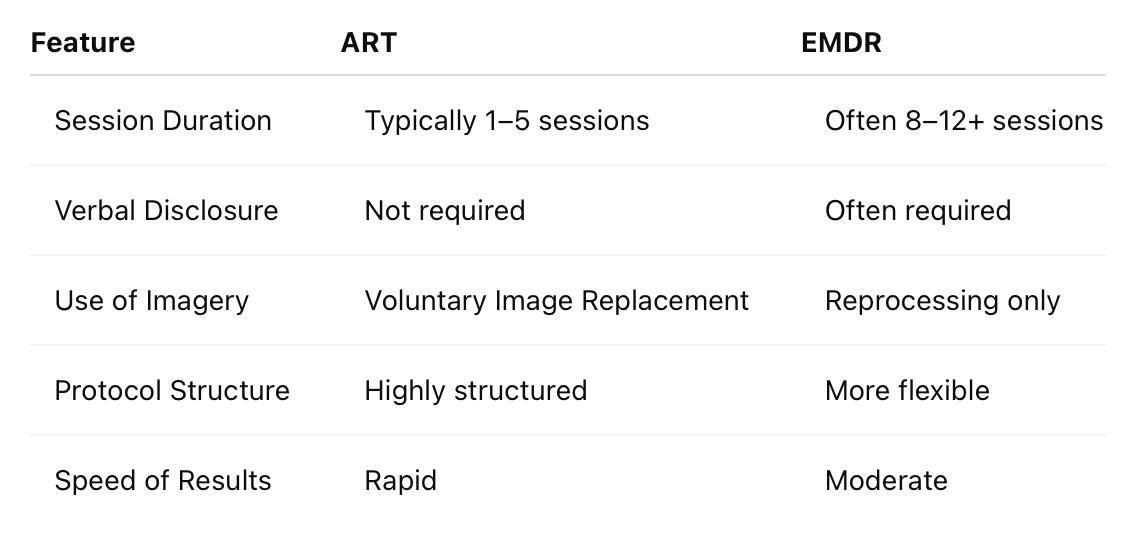Accelerated Resolution Therapy: How It Works & What to Expect
Accelerated Resolution Therapy (ART) is gaining recognition as a powerful, brief therapy for individuals struggling with trauma, anxiety, and other mental health issues. While traditional talk therapy often takes months or even years to produce lasting results, ART is designed to bring relief in as few as one to five sessions. This blog post will walk you through how ART works, what you can expect during an ART session, the science behind it, and the types of conditions it treats.
What Is Accelerated Resolution Therapy?
Accelerated Resolution Therapy (ART) is a structured, evidence-based form of psychotherapy developed in 2008 by Laney Rosenzweig, LMFT. ART combines elements of several therapeutic modalities, including:
Eye Movement Desensitization and Reprocessing (EMDR)
Cognitive Behavioral Therapy (CBT)
Guided imagery
Memory reconsolidation
The key mechanism of ART involves using bilateral eye movements to help reprocess distressing memories, images, and sensations so they no longer trigger emotional or physical symptoms. What sets ART apart is its focus on Voluntary Image Replacement (VIR), which allows clients to actively replace disturbing images with more positive or neutral ones.
How Does ART Work?
ART works by targeting how memories are stored in the brain, rather than the factual content of those memories. When someone experiences trauma, their brain often stores the memory in a way that continues to trigger emotional or physical responses long after the event has ended. ART aims to desensitize those responses and reprogram the brain’s association with the traumatic memory.
Key Components of ART:
Eye Movements: Clients follow the therapist's hand with their eyes, which stimulates both hemispheres of the brain. This process helps reduce the emotional intensity associated with the memory.
Visualization: Clients are asked to visualize the traumatic memory, focusing on the sensations, images, and feelings involved.
Voluntary Image Replacement: Once desensitization is achieved, clients are guided to replace the disturbing imagery with more calming or empowering images.
Body Scan: Clients check in with their bodies to notice any lingering physical tension or discomfort and release it.
This process is repeated until the memory no longer triggers distress.
What to Expect During an ART Session
If you're considering ART, it helps to know what the experience is like. Sessions are typically 60 to 75 minutes and follow a structured protocol.
Step-by-Step Breakdown:
Initial Consultation: The therapist explains ART and identifies a target issue or memory.
Eye Movement Sets: The therapist leads you through a series of rapid eye movements as you recall the memory.
Desensitization: Emotional intensity around the memory begins to fade.
Image Replacement: You replace the disturbing imagery with a positive or neutral image.
Body Work: A scan of your body ensures all sensations tied to the trauma are addressed.
Closure: The therapist checks in to confirm the distress has significantly decreased or resolved.
You don’t have to verbalize the memory or relive it in detail, making ART especially useful for clients who find it difficult to talk about their trauma.
Conditions Treated with ART
ART is highly effective for a wide range of psychological conditions:
Post-Traumatic Stress Disorder (PTSD)
Complex PTSD
Anxiety and panic attacks
Depression
Grief and loss
Phobias and fears
Obsessive-compulsive behaviors
Substance use triggers
Sleep issues
Performance anxiety
It’s also popular among veterans, first responders, and survivors of abuse or assault.
Research and Evidence Supporting ART
ART is supported by numerous peer-reviewed studies and is listed on the Substance Abuse and Mental Health Services Administration (SAMHSA) National Registry of Evidence-Based Programs and Practices.
Notable Studies:
Kip et al. (2013): Found that ART significantly reduced PTSD symptoms in military veterans in just 3-5 sessions. View study
Kip et al. (2016): Showed positive outcomes in treating depression, anxiety, and trauma. View study
D’Andrea et al. (2013): Demonstrated ART’s effectiveness with survivors of sexual assault. Read more
Benefits of ART
Fast Results: Most people feel significantly better in 1–5 sessions.
Non-Verbal Processing: You don’t have to talk through your trauma.
Low Drop-Out Rates: Clients are more likely to complete ART compared to longer therapies.
Safe and Controlled: You remain in control of the memory and imagery at all times.
Holistic Relief: Reduces both emotional and physical symptoms of trauma.
Possible Side Effects
ART is generally well-tolerated, but some individuals may experience temporary side effects:
Emotional fatigue during or after a session
Vivid dreams
Short-lived increase in emotional sensitivity
Physical tiredness
These symptoms usually resolve within 24–48 hours.
How to Find an ART Therapist
If you’re searching for “accelerated resolution therapy near me,” it’s important to find a certified ART practitioner. The ART International Training and Research directory is a great place to start:
🔗 Find a Certified ART Therapist
Make sure the therapist is trained specifically in ART protocols, as the technique is distinct from EMDR and other therapies.
ART vs. EMDR: What's the Difference?
Though similar in their use of eye movements, ART and EMDR are different in structure and execution.
ART tends to be preferred by clients who want faster relief and less verbal processing.
Final Thoughts
Accelerated Resolution Therapy is an exciting development in trauma-informed care. Its unique combination of speed, non-invasiveness, and proven results make it an attractive option for people seeking relief from emotional distress. Whether you’re dealing with PTSD, anxiety, or even chronic grief, ART can help you feel better—often in just a few sessions.
If you’re ready to explore healing through a new lens, consider scheduling an ART session with a certified therapist. It might just be the breakthrough you’ve been waiting for.

